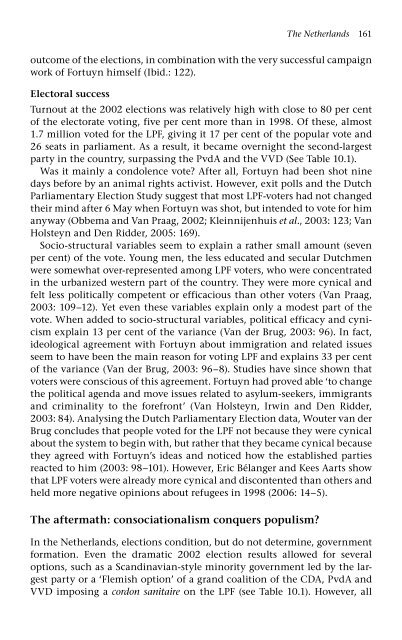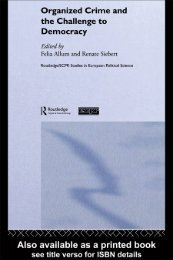Twenty-First Century Populism: The Spectre of Western European ...
Twenty-First Century Populism: The Spectre of Western European ...
Twenty-First Century Populism: The Spectre of Western European ...
You also want an ePaper? Increase the reach of your titles
YUMPU automatically turns print PDFs into web optimized ePapers that Google loves.
<strong>The</strong> Netherlands 161<br />
outcome <strong>of</strong> the elections, in combination with the very successful campaign<br />
work <strong>of</strong> Fortuyn himself (Ibid.: 122).<br />
Electoral success<br />
Turnout at the 2002 elections was relatively high with close to 80 per cent<br />
<strong>of</strong> the electorate voting, five per cent more than in 1998. Of these, almost<br />
1.7 million voted for the LPF, giving it 17 per cent <strong>of</strong> the popular vote and<br />
26 seats in parliament. As a result, it became overnight the second-largest<br />
party in the country, surpassing the PvdA and the VVD (See Table 10.1).<br />
Was it mainly a condolence vote? After all, Fortuyn had been shot nine<br />
days before by an animal rights activist. However, exit polls and the Dutch<br />
Parliamentary Election Study suggest that most LPF-voters had not changed<br />
their mind after 6 May when Fortuyn was shot, but intended to vote for him<br />
anyway (Obbema and Van Praag, 2002; Kleinnijenhuis et al., 2003: 123; Van<br />
Holsteyn and Den Ridder, 2005: 169).<br />
Socio-structural variables seem to explain a rather small amount (seven<br />
per cent) <strong>of</strong> the vote. Young men, the less educated and secular Dutchmen<br />
were somewhat over-represented among LPF voters, who were concentrated<br />
in the urbanized western part <strong>of</strong> the country. <strong>The</strong>y were more cynical and<br />
felt less politically competent or efficacious than other voters (Van Praag,<br />
2003: 109−12). Yet even these variables explain only a modest part <strong>of</strong> the<br />
vote. When added to socio-structural variables, political efficacy and cynicism<br />
explain 13 per cent <strong>of</strong> the variance (Van der Brug, 2003: 96). In fact,<br />
ideological agreement with Fortuyn about immigration and related issues<br />
seem to have been the main reason for voting LPF and explains 33 per cent<br />
<strong>of</strong> the variance (Van der Brug, 2003: 96−8). Studies have since shown that<br />
voters were conscious <strong>of</strong> this agreement. Fortuyn had proved able ‘to change<br />
the political agenda and move issues related to asylum-seekers, immigrants<br />
and criminality to the forefront’ (Van Holsteyn, Irwin and Den Ridder,<br />
2003: 84). Analysing the Dutch Parliamentary Election data, Wouter van der<br />
Brug concludes that people voted for the LPF not because they were cynical<br />
about the system to begin with, but rather that they became cynical because<br />
they agreed with Fortuyn’s ideas and noticed how the established parties<br />
reacted to him (2003: 98−101). However, Eric Bélanger and Kees Aarts show<br />
that LPF voters were already more cynical and discontented than others and<br />
held more negative opinions about refugees in 1998 (2006: 14−5).<br />
<strong>The</strong> aftermath: consociationalism conquers populism?<br />
In the Netherlands, elections condition, but do not determine, government<br />
formation. Even the dramatic 2002 election results allowed for several<br />
options, such as a Scandinavian-style minority government led by the largest<br />
party or a ‘Flemish option’ <strong>of</strong> a grand coalition <strong>of</strong> the CDA, PvdA and<br />
VVD imposing a cordon sanitaire on the LPF (see Table 10.1). However, all



